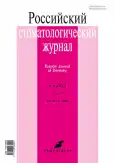Analysis of the use of classical compression–distraction devices and the latest device for continuous distraction
- Authors: Kalugina L.S.1, Topolnitsky O.Z.1, Fedotov R.N.1, Beglaryan A.A.1, Afaunova O.A.1, Minnakhmetova D.R.1
-
Affiliations:
- Russian University of Medicine
- Issue: Vol 27, No 6 (2023)
- Pages: 541-549
- Section: Clinical Investigation
- URL: https://journals.rcsi.science/1728-2802/article/view/254406
- DOI: https://doi.org/10.17816/dent112077
- ID: 254406
Cite item
Abstract
BACKGROUND: The device used in bone tissue fragment mechanical displacement by expanding the piston between rigidly fixed device legs on the bone fragments is known in classical compression–distraction osteogenesis. In such cases, the control of the displacement is partly left to the patient, since the screw turning must be performed in four sessions per day, and the doctor does not constantly have the opportunity to do it personally, which can lead to uncontrollable results of bone regeneration. To fully control the patient's treatment during distraction, a device that operates continuously and autonomously is required.
AIM: Creation and experimental testing of an automatic distraction device for continuous distraction followed by a study of the obtained bone regenerates and its implementation in practical maxillofacial surgery.
MATERIALS AND METHODS: To fully control the patient’s treatment during the distraction, we developed an unparalleled distraction device based on the principle of continuous bone fragment separation, with a motor in which the piston is activated by an electrochemical reaction. The device performs distraction continuously, around the clock, and autonomously under the control and monitoring of the software and the possibility of remote access. This study included analysis of statistical data on patient treatment in the Russian University of Medicine Department of Pediatric Maxillofacial Surgery Clinic between 2010 and 2021, development and bench testing of devices and electronics, clinical trials of models of devices for continuous distraction at various rates (1, 2, and 3 mm/day) on experimental animals (dogs), X-ray control at the stages of testing, research and analysis of the morphological structure of the resulting bone regenerates, creation of clinical guidelines for the use of a continuous distraction day device, and identification of its advantages compared with the classic fractional compression–distraction device.
RESULTS: Statistical data analysis revealed that 362 patients were treated with distraction devices. This is a relatively high percentage in relation to all patients in the clinic. Studies of the morphological structure of regenerates obtained by continuous distraction with our latest device revealed a higher rate and control of regenerates, good quality characteristics, and histomorphological maturity, most pronounced in regenerates obtained by continuous distraction at a rate of 2 mm/day.
CONCLUSION: The need for treatment with distraction osteogenesis in the department’s clinic is rather high; hence, this process should be controlled to improve treatment quality and speed. Our automatic distraction device designed for continuous distraction may be implemented and applied in practical medicine at an appropriate rate of 2 mm/day.
Full Text
##article.viewOnOriginalSite##About the authors
Lubov’ S. Kalugina
Russian University of Medicine
Email: lubbs@mail.ru
ORCID iD: 0000-0001-8804-3184
SPIN-code: 2522-4370
Russian Federation, Moscow
Orest Z. Topolnitsky
Russian University of Medicine
Email: proftopol@mail.ru
ORCID iD: 0000-0002-3896-3756
SPIN-code: 1981-5376
MD, Dr. Sci. (Medicine), Professor
Russian Federation, MoscowRoman N. Fedotov
Russian University of Medicine
Email: Abilat@yandex.ru
ORCID iD: 0000-0003-1802-1080
SPIN-code: 1777-9398
MD, Cand. Sci. (Medicine), Associate Professor
Russian Federation, MoscowAlina A. Beglaryan
Russian University of Medicine
Email: dr.beglaryanalina@mail.ru
ORCID iD: 0000-0003-1133-5829
SPIN-code: 3670-5875
Russian Federation, Moscow
Olga A. Afaunova
Russian University of Medicine
Author for correspondence.
Email: Afa-afa15@mail.ru
ORCID iD: 0000-0002-9192-8044
SPIN-code: 7735-1559
Russian Federation, Moscow
Diana R. Minnakhmetova
Russian University of Medicine
Email: dianaminn@mail.ru
ORCID iD: 0000-0002-1393-342X
SPIN-code: 2062-7968
Russian Federation, Moscow
References
- Shevtsov VI, Yerofeyev SA, Gorbach EN, Yemanov AA. Osteogenesis features for leg lengthening using automatic distractors with the rate by 3 mm for 180 times (an experimental study). Genij Ortopedii. 2006;(1):10–16. EDN: IYDANV
- Amarnath BC, Dharma RM, Prashanth CS, Rajkumar GC. Distraction osteogenesis, a new hope for tmj ankylosis (case report). Journal of Dental Sciences and Research. 2011;2(1):108–115.
- McCarthy JG, Williams JK, Grayson BH, Crombie JS. Controlled multiplanar distraction of the mandible: device development and clinical application. J Craniofac Surg. 1998;9(4):322–329. doi: 10.1097/00001665-199807000-00006
- Choi IH, Chung CY, Cho TJ, Yoo WJ. Angiogenesis and mineralization during distraction osteogenesis. J Korean Med Sci. 2002;17(4):435–447. doi: 10.3346/jkms.2002.17.4.435
- Mandell DL, Yellon RF, Bradley JP, et al. Mandibular distraction for micrognathia and severe upper airway obstruction. Arch Otolaryngol Head Neck Surg. 2004;130(3):344–348. doi: 10.1001/archotol.130.3.344
- Korkmaz M, Oztürk H, Bulut O, et al. The effect of definitive continuous distraction employed with the Ilizarov type external fixation system on fracture healing: an experimental rabbit model. Acta Orthop Traumatol Turc. 2005;39(3):247–257. (In Turkish).
- Menon S, Manerikar R, Roy Chowdhury SK, Murali Mohan S. Distraction osteogenesis in management of mandibular deformities. Med J Armed Forces India. 2005;61(4):345–347. doi: 10.1016/S0377-1237(05)80061-9
- Monasterio FO, Molina F, Berlanga F, et al. Swallowing disorders in Pierre Robin sequence: its correction by distraction. J Craniofac Surg. 2004;15(6):934–941. doi: 10.1097/00001665-200411000-00009
Supplementary files













